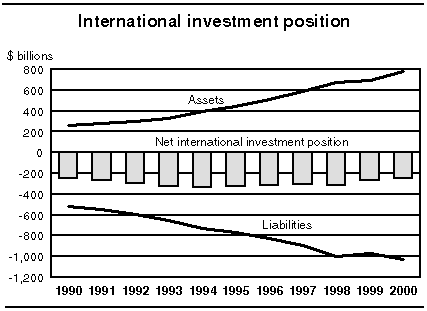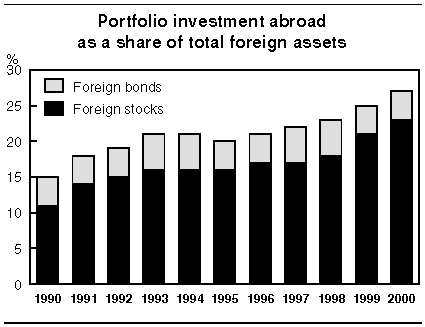 View the most recent version.
View the most recent version.Information identified as archived is provided for reference, research or recordkeeping purposes. It is not subject to the Government of Canada Web Standards and has not been altered or updated since it was archived. Please "contact us" to request a format other than those available.

The Daily. Tuesday, March 27, 2001
Canada's net liability to foreign residents - the difference between its external assets and external liabilities - declined for the fifth time in the past six years in 2000. At end of the year, net foreign liability amounted to $244 billion, down 10% from the end of 1999.
External assets totalled $779 billion, an 11.5% increase and more than twice the pace of the 5.5% gain in external liabilities, which reached $1,023 billion.
As a result, net foreign liabilities fell to 23% of gross domestic product, their lowest point since the early 1950s.

The increase in Canada's external liabilities in 2000 was fuelled by large takeovers. However, foreign investment in Canadian portfolio securities, which accounts for almost half of external liabilities, increased by less than 1%.
A substantial increase in the holdings of Canadian stocks by foreign investors compensated for a decrease in their holdings of Canadian bonds. This activity has led to direct investment growing in importance relative to portfolio investment as a percentage of gross liabilities.
The large takeovers brought the European Union's share of total direct investment in Canada to 27%, up from 20% in 1999. Direct investment originating from the European Union amounted to $78 billion at the end of 2000, twice as large as it was five years ago.
However, the United States, still by far the largest direct investor in Canada at $186 billion, saw its share of total direct investment decline to 64%, down from 69% in 1999.
The impact of these large takeovers on year-end positions is less dramatic than it is on transaction values, as international investment positions data are recorded at book value, which does not reflect large market fluctuations.
The depreciation of the Canadian dollar against the U.S. dollar added $8 billion to the portfolio position, which otherwise would have declined in 2000 as a result of an unprecedented reduction of foreign holdings of Canadian bonds.
The value of foreign holdings of Canadian bonds decreased for the second consecutive year, and has been decreasing as a proportion of total external liabilities since 1995. However, at $381 billion it still accounted for 37% of foreign investment in Canada at the end of 2000.
This decrease originated in all levels of governments and their enterprises (-9%), reflecting the fact that Canadian governments have increasingly financed their lower capital needs in Canadian markets. However, foreign holdings of Canadian corporate bonds rose 7%. As a share of total foreign-held bonds, corporate bonds have been an increasing proportion for the last six years, reaching 39% in 2000.
Growth in Canadian direct investment abroad is also largely explained by important acquisitions. At the end of 2000, 51% of direct investment abroad was in the United States; the remainder was geographically broadly-dispersed.
The growth of portfolio investment abroad by Canadian residents, largely through pension and mutual funds, averaged more than 18% for each of the past five years. It reached $212 billion in 2000, representing 27% of Canada's external assets, up from 15% in 1990.
In 2000, higher foreign content limits for tax-sheltered Canadian investment funds explained part of this growth during a time of generally poorer performance of foreign financial markets. Another important component of the growth was the receipt by Canadian portfolio shareholders of new treasury shares of foreign companies exchanged in the acquisition of Canadian firms.

Available on CANSIM: matrices 4180-4190, 4194 and 4195.
Canada's international investment position, 2000 (67-202-XIB, $39; 67-202-XPB, $52) is now available. See How to order products.
For more information, or to enquire about the concepts, methods or data quality of this release, contact Christian Lajule (613-951-2062), Balance of Payments Division.
Canada's international investment position at year-end
| 1995 | 1996 | 1997 | 1998 | 1999 | 2000 | ||||
|---|---|---|---|---|---|---|---|---|---|
| $ billions | |||||||||
| Assets | |||||||||
| Canadian direct investment abroad | 161.2 | 181.2 | 213.6 | 255.6 | 270.2 | 301.4 | |||
| Portfolio investment | |||||||||
|
18.8 | 21.3 | 26.9 | 33.5 | 30.1 | 34.7 | |||
|
71.9 | 87.0 | 100.1 | 120.5 | 145.9 | 177.4 | |||
| Other investments | |||||||||
|
43.2 | 49.1 | 70.6 | 60.4 | 55.9 | 60.0 | |||
|
-11.8 | -11.4 | -10.3 | -10.8 | -10.8 | -10.8 | |||
|
80.6 | 99.0 | 102.1 | 118.4 | 108.8 | 109.1 | |||
|
20.8 | 28.2 | 25.7 | 35.9 | 41.5 | 47.8 | |||
|
58.5 | 54.6 | 62.5 | 63.3 | 57.5 | 59.7 | |||
| Total assets | 443.3 | 509.1 | 591.1 | 676.8 | 699.0 | 779.3 | |||
| Liabilities | |||||||||
| Foreign direct investment In Canada | 168.2 | 182.1 | 198.2 | 221.6 | 246.8 | 291.5 | |||
| Portfolio investment | |||||||||
|
341.7 | 357.9 | 369.4 | 408.8 | 394.5 | 381.3 | |||
|
37.1 | 47.3 | 51.4 | 64.6 | 70.2 | 85.9 | |||
|
44.1 | 38.1 | 41.6 | 44.1 | 30.1 | 29.5 | |||
| Other investment | |||||||||
|
48.8 | 51.0 | 50.5 | 54.8 | 55.5 | 60.0 | |||
|
109.3 | 126.8 | 165.4 | 180.7 | 152.0 | 153.9 | |||
|
18.3 | 17.2 | 18.6 | 19.2 | 20.5 | 20.9 | |||
| Total liabilities | 767.5 | 820.5 | 895.1 | 993.9 | 969.7 | 1,023.0 | |||
| Net international investment position | -324.2 | -311.4 | -304.0 | -317.1 | -270.7 | -243.7 | |||